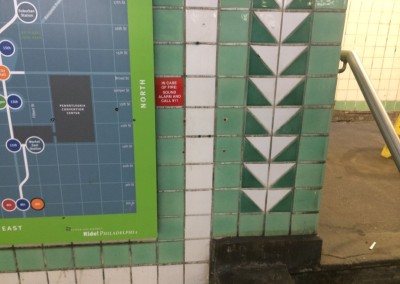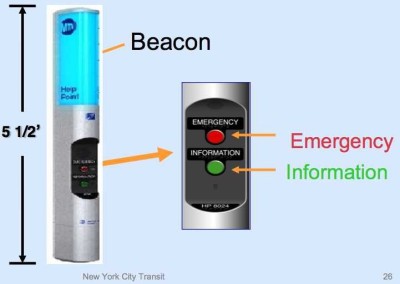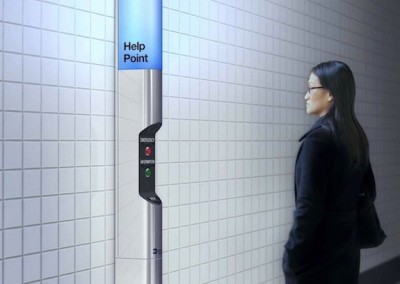Increase Number and Presence of Updated “Help Points”
Nudging Up Customer Service: Long-Term SolutionProblem, Classification, and Idea
Customers are increasingly wary of their safety throughout the SEPTA system, most notably in walkways and the large concourse area. Emergency Call Boxes help reduce this concern, as customers know they can quickly and rapidly reach police if necessary. In addition to the emergency functionality, these boxes can be expanded to also serve customers needing information throughout the system. These two features would greatly improve customers’ perceptions of security as well as the ease with which they navigate the concourse areas.
Implementation
Modeled after the newly-designed “Help Point” found in the NYC Subway system, the devices upon installation would be quite similar in operation to the current emergency intercoms; however, they would also feature the ability for customers to communicate with the 4th Floor Customer Service Center and ask for directions or navigation information. First and foremost, these new devices should be installed as part of the concourse rehabilitation improvement project. Doing so not only would make the area more secure (as many emergency call boxes have been removed from the area), but it would also make it easier for customers to navigate the concourse (as call center attendants would be able to specifically identify from where the call is being placed and then offer directions accordingly). Such a project would be costly to install; however, given that the funds exist (as money has already been appropriated fund such concourse improvements) and the devices would improve both Customer Service and Security, their installation should be done without hesitation.
Beyond the concourses, expanding these devices throughout the system would also be beneficial. However, as previously stated, managing the high capital outflow would be necessary before such in-system devices were installed.
Notes & Graphics
The initiative began in May of 2010 after the MTA Chairman identified three problems with the preexisting audio intercoms which translated into three design features of the Help Points:
- Wayfinding
- They are difficult to find (boxes are small and often hidden).
- SOLUTION: Tall, slim, and visible with a blue light on the top.
- Response Time
- They take a while to connect (15 rings on average when they even work).
- SOLUTION: All-digital connection leads to immediate connections in less than three seconds.
- Audio Quality
- It is difficult to hear the person on the other end.
- SOLUTION: All-digital connection leads to crystal clear audio.
- The manufacturer (BTI – Boyce Tech Incorporated) is a pre-approved vendor who was responsible for much of the design of the NYC Subway System.
- The physical units are modular in nature meaning they could use either wired or wireless technology and can be expanded to include things like video cameras.
- Each device has an IP address and is connected to a backend LAN.
- To minimize the costs of wiring with wired units, the MTA utilizes some of the existing unused wires found in TransitWireless’ cellular/wifi base station.
- Units themselves cost $11,000. The MTA budgets 350-400k per station towards help point deployments factoring in every aspect of implementation costs (although this would be less for SEPTA given that we would need fewer units per station and much of the infrastructure necessary to support this program already exists).
- Help points are placed on each platform with one at the 1/4 and 3/4 points of elevated platforms and one at the 1/6, 1/2, and 5/6 points of underground stations (however, SEPTA would need fewer since our platforms are 2/3 to half the length of a typical MTA station).
- The biggest benefit they see is the immediate connection to the control center and customer service center in the event that customers encounter an emergency or need assistance.
Next Steps
- Speak with operations and station facility persons about the opportunity to install these throughout the system (potentially as a pilot at a center city station with many passengers).
- Determine if it would be useful to integrate NPT into these help points such that customers with card issues could receive remote support without the need for a human directly at every station entrance to handle every problem.




